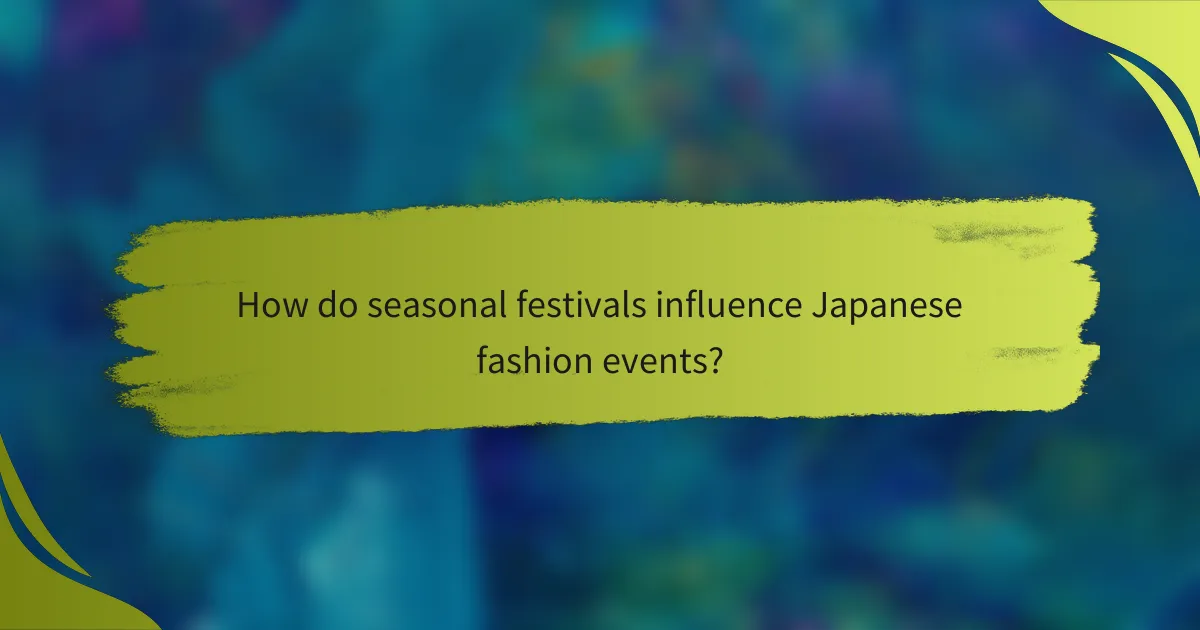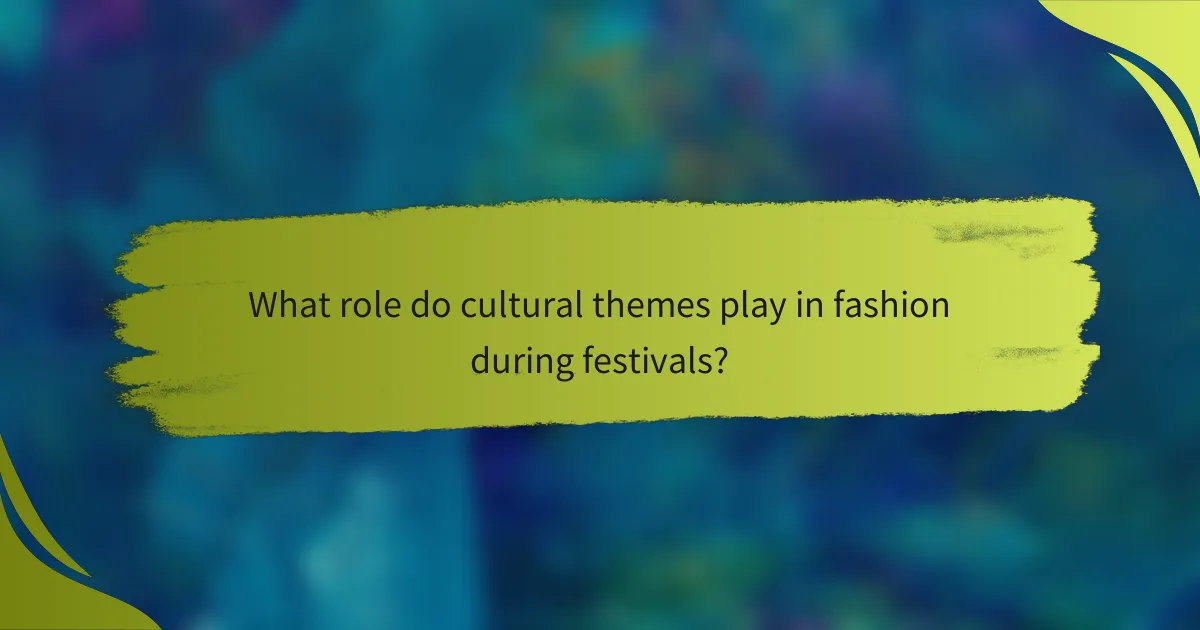日本の季節祭りは、デザイナーが作品を披露し、文化的テーマとつながるプラットフォームを提供することで、ファッションイベントに大きな影響を与えています。これらのイベントでは、伝統的な衣装と現代的なスタイルが融合し、地元および国際的な観客に響く独自のスタイルを生み出しています。

How do seasonal festivals influence Japanese fashion events?
Seasonal festivals in Japan significantly impact fashion events by providing a platform for designers to showcase their work and connect with cultural themes. These events often highlight traditional attire while integrating contemporary styles, creating a unique fusion that resonates with both local and international audiences.
Increased visibility for designers
Seasonal festivals attract large crowds, offering designers a chance to gain exposure and showcase their collections. Events like Hanami (cherry blossom viewing) and Tanabata (star festival) allow designers to present their work in vibrant, culturally rich settings, enhancing their visibility.
Participating in these festivals can lead to increased media coverage and social media engagement, which are crucial for emerging designers. The festive atmosphere encourages attendees to share their experiences online, further amplifying the reach of the showcased designs.
Emergence of seasonal trends
Fashion trends in Japan often emerge during seasonal festivals, as designers draw inspiration from the themes and colors associated with each event. For instance, spring festivals may inspire pastel colors and floral patterns, while autumn festivals might highlight earthy tones and layered clothing.
These trends not only reflect the changing seasons but also influence consumer purchasing behavior, as shoppers look for attire that aligns with the festive spirit. Designers who can quickly adapt to these trends often see increased sales during the festival periods.
Collaboration opportunities with local artisans
Seasonal festivals provide a unique opportunity for designers to collaborate with local artisans, enhancing the authenticity of their collections. By incorporating traditional techniques and materials, designers can create pieces that resonate with the cultural heritage of the festival.
Such collaborations can lead to innovative designs that attract attention and appreciation from both locals and tourists. Additionally, these partnerships often support local economies, fostering a sense of community and shared cultural pride.

What are the key seasonal festivals in Japan?
Japan is home to several key seasonal festivals that significantly influence its cultural landscape and fashion events. These festivals, celebrated throughout the year, showcase traditional attire and contemporary styles, reflecting the changing seasons and local customs.
Cherry Blossom Festival
The Cherry Blossom Festival, or Hanami, occurs in spring as cherry trees bloom across Japan. This celebration invites people to gather in parks for picnics under the blossoms, often wearing traditional kimono or modern outfits inspired by the floral theme.
Fashion during this festival tends to be light and colorful, with pastel shades dominating. Many attendees opt for floral patterns, which symbolize renewal and beauty, making it a prime opportunity for designers to showcase spring collections.
Gion Matsuri
Gion Matsuri, held in July in Kyoto, is one of Japan’s most famous festivals, featuring elaborate floats and traditional performances. The event’s attire is characterized by yukata, a casual summer kimono, which is widely worn by both locals and tourists during the festivities.
This festival not only highlights traditional craftsmanship but also influences modern fashion trends, as designers often draw inspiration from the vibrant colors and intricate patterns of the floats. Attendees should consider wearing comfortable yet stylish footwear, as the festival involves extensive walking.
Tanabata Festival
The Tanabata Festival, celebrated in July, is based on a romantic legend about two stars. During this festival, people write wishes on colorful strips of paper and hang them on bamboo branches, creating a vibrant display of hopes and dreams.
Fashion during Tanabata often includes bright, cheerful colors reflecting the spirit of the festival. Many participants wear yukata, and some fashion designers incorporate star motifs into their collections, making it a unique blend of tradition and modernity. It’s advisable to choose lightweight fabrics, as summer temperatures can be quite high.

How do fashion brands leverage seasonal festivals?
Fashion brands capitalize on seasonal festivals by creating unique marketing strategies that resonate with cultural themes and consumer sentiments. These strategies often include limited edition collections, pop-up events, and targeted social media campaigns that enhance brand visibility and engagement during festive periods.
Limited edition collections
Limited edition collections are a popular tactic for fashion brands during seasonal festivals. By designing exclusive items that reflect the festival’s themes, brands can create a sense of urgency and excitement among consumers. For instance, a brand might release a special kimono line for the Cherry Blossom Festival, appealing to both locals and tourists.
These collections often feature unique patterns, colors, or materials that align with the festival’s cultural significance. Brands should consider pricing strategies that reflect the exclusivity of these items, typically setting them at a premium to enhance perceived value.
Pop-up events during festivals
Pop-up events are temporary retail spaces that brands set up during festivals to attract foot traffic and engage with customers directly. These events can be strategically located near festival venues to maximize visibility. For example, a fashion brand might host a pop-up shop at a summer matsuri, offering exclusive merchandise and interactive experiences.
To ensure success, brands should focus on creating immersive experiences that resonate with festival-goers. This could include live fashion shows, workshops, or collaborations with local artists, which not only draw attention but also foster community engagement.
Social media campaigns
Social media campaigns are essential for promoting fashion brands during seasonal festivals. By leveraging platforms like Instagram and Twitter, brands can share visually appealing content that highlights their festival-related offerings. Engaging with users through hashtags related to the festival can significantly increase reach and interaction.
Brands should consider running contests or giveaways that encourage user-generated content, such as sharing photos in festival attire. This not only boosts brand visibility but also cultivates a sense of community among followers, enhancing brand loyalty during and after the festival season.

What role do cultural themes play in fashion during festivals?
Cultural themes significantly influence fashion during festivals in Japan, as they reflect the heritage and traditions of the community. Designers often draw inspiration from these themes to create unique collections that resonate with the spirit of the celebrations.
Inspiration from traditional attire
Traditional Japanese clothing, such as kimono and yukata, serves as a primary source of inspiration for contemporary fashion during festivals. Designers incorporate elements like fabric patterns, colors, and silhouettes from these garments to create modern interpretations that honor cultural roots.
For example, during the Gion Matsuri in Kyoto, many fashion shows feature designs that echo the vibrant colors and intricate patterns of traditional kimonos, blending old and new styles seamlessly.
Integration of local motifs
Local motifs play a crucial role in festival fashion, as they reflect the unique identity of different regions in Japan. Designers often use symbols, patterns, and colors that are specific to local festivals, enhancing the cultural significance of their collections.
For instance, the use of cherry blossom motifs during Hanami festivals not only celebrates the season but also connects the fashion to the cultural practices surrounding the event.
Promotion of sustainability
Festivals in Japan increasingly emphasize sustainability in fashion, encouraging designers to use eco-friendly materials and practices. This shift aligns with a growing awareness of environmental issues and the desire to preserve cultural heritage.
Many brands now focus on upcycling traditional fabrics or using organic materials, promoting a sustainable approach that respects both the environment and cultural traditions. This trend is evident in events like the Awa Odori, where many participants wear outfits made from recycled textiles.

How do consumer behaviors change during festival seasons?
During festival seasons in Japan, consumer behaviors shift significantly, leading to increased spending and a heightened interest in fashion. This change is driven by cultural traditions, social gatherings, and the desire to showcase personal style during celebrations.
Increased spending on fashion
Festival seasons often see a notable rise in consumer spending on fashion, as individuals seek to purchase new outfits for events. Many people allocate a larger portion of their budgets to clothing, accessories, and footwear, aiming to stand out during festivities.
Retailers typically respond to this trend by launching special collections or promotional sales tailored to the festival season. Shoppers can expect discounts ranging from 10% to 30% on seasonal items, making it an opportune time to refresh their wardrobes.
Preference for local brands
During festivals, there is a strong preference for local Japanese brands, as consumers often wish to support homegrown talent and craftsmanship. This trend is particularly evident in traditional clothing, such as yukatas and kimonos, which are favored for their cultural significance.
Local brands often capitalize on this preference by highlighting their heritage and quality, appealing to consumers’ desire for authenticity. Shoppers may find that local fashion items not only reflect their personal style but also resonate with their cultural identity during festival celebrations.
